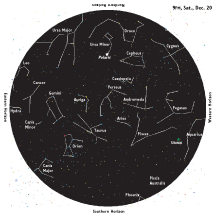
|
Volume 16, Issue 51 - December 18 - December 24, 2008
|
|
Columns |
 |
Sky Watch by J. Alex Knoll
The Day the Sun Stood Still
Winter is truly here
Sunday, December 21, marks winter solstice, the shortest day of the year and the start of winter for us in the Northern Hemisphere, with a mere nine hours 25 minutes 54 seconds of sunlight. On this day, the sun appears to stand still, the meaning of solstice, directly above the Tropic of Capricorn, latitude 231⁄2 degrees south. For those of us in the Northern Hemisphere, however, the sun is at its lowest point in the sky as its arcs from east to west, and the farther north you go, the lower the sun climbs, to the point that those north of the Arctic Circle receive no sunlight.
All this is a result of earth’s axis, an imaginary line through the planet extending from the north and south poles. If earth’s axis were true in relation to the sun, it would spin like a balanced top with the sun always facing the equator. However, earth rotates on a 231⁄2-degree tilted axis as it orbits the sun. From December 21 until March 21, vernal equinox, earth’s axis points away from the sun, bathing the Southern Hemisphere in an abundance of light. From June 21, summer solstice, until September 21, autumnal equinox, the axis points toward the sun, washing us in daylight.
For those living between the Tropic of Capricorn and the Tropic of Cancer, the sun never dips too low, which is why we describe those areas as tropical.
Without our 231⁄2-degree tilted axis, the sun would always shine the same number of hours over the same latitude, day after day, depriving us of our changing seasons. It would always be summer along the equator, while north of the Tropic of Cancer and south of the Tropic of Capricorn would experience perpetual winter. Agriculture as we know it would not exist, for it would be limited to a narrow band of temperate land.